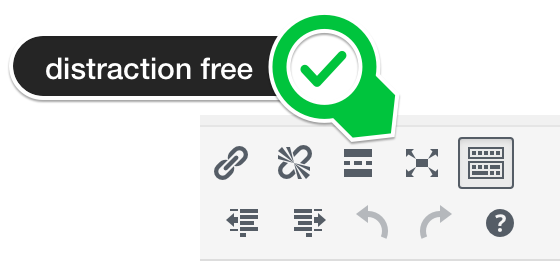The content analysis in the Yoast SEO plugin assesses crucial aspects of the posts and pages you add to your website. In particular, it checks how SEO friendly and easy to read your content is. Here, we’ll go through the most important features of this tool. Check out our step-by-step guide on to optimize your page and learn how to interpret the feedback you’ll get.
The content analysis: readability and SEO
You’ll find our readability and SEO analysis in the Yoast SEO meta box and the Yoast SEO sidebar (the latter only if you use the WordPress Block editor). So, when you’re working on your post or page just scroll down to find them in the meta box below your post:
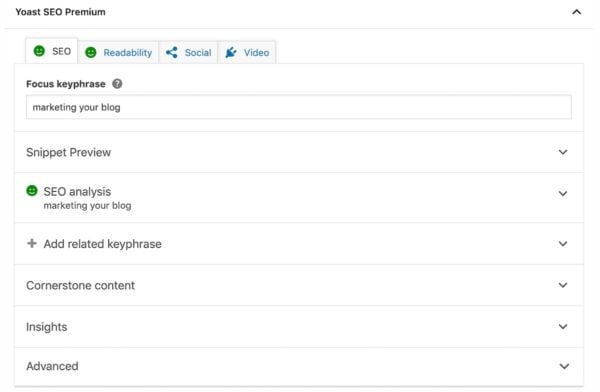
Or, in the Block Editor, click on the Yoast icon in the upper right corner of your screen to see the Yoast SEO sidebar:
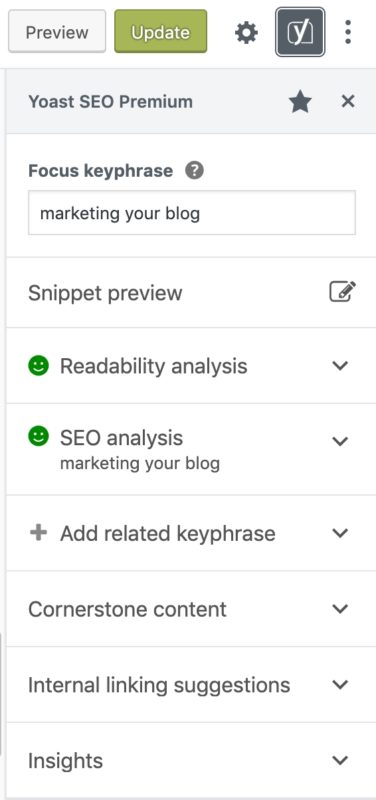
Here, we’ll be focusing on the SEO and readability analysis. But we’ll also have a quick look at the Social tab and the Cornerstone content section because it’s important to use those correctly when you’re optimizing your post or page.
The readability analysis
The readability analysis aims to help you write text which is easy to read and understand. Foremost, this is crucial if you want readers to stay, read your text and understand what you’re writing about. Or perhaps even take action, for instance, if you’re explaining how to perform a certain task in your post. Secondly, search engines love readable copy! That’s why you should invest some time in writing in plain language.
The readability analysis includes several checks based on the characteristics of a text that is easy to read and understand:
If you write a readable text, based on the criteria above, the plugin will reward you with a green bullet.
The SEO analysis
Readability is essential, but there’s more to focus on if you want to create a search-engine-friendly page on your website. That’s why we have an SEO analysis too!
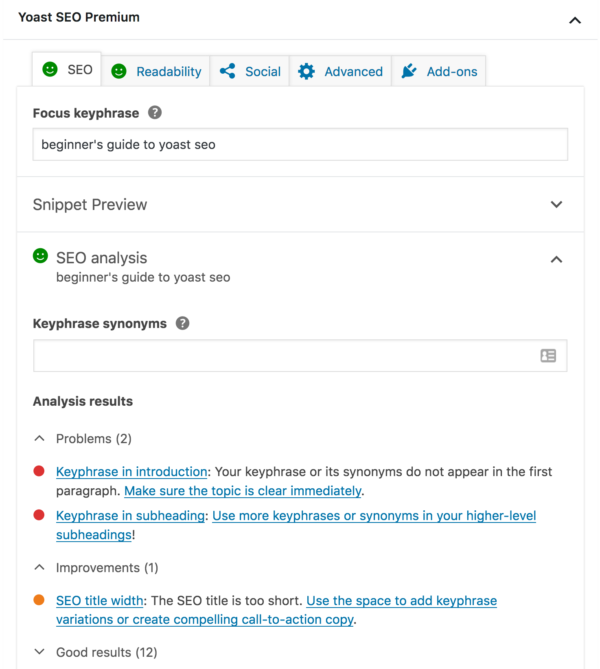
To get the most out of the SEO analysis, you’ll have to enter a focus keyphrase first. The focus keyphrase is the phrase you’d like your post to rank for. You should determine what phrases you’d like to rank for by doing keyword research.
Once you’ve entered your focus keyphrase, the SEO analysis checks the presence of your focus keyphrase in:
The plugin calculates the number of words and frequency of the focus keyphrase in your article. In addition to this, Yoast SEO Premium checks how you distributed the keywords on your page. Your article should contain your focus keyphrase or its synonyms evenly throughout the text.
And it checks whether you’re using the exact same focus keyphrase on other pages of your website so you don’t accidentally compete with yourself. If you were to optimize two different articles for the same focus keyphrase, you could have both posts turn up in the same search on Google. Read why you shouldn’t use your focus keyphrase more than once.
And, last but not least, Yoast SEO has several links and image checks for your article.
If you write a relatively SEO-friendly article – based on the above criteria – the plugin will reward you with a green bullet. If you follow the instructions and craft your pages and posts so they get green bullets, they have a better chance of ranking high in search.
On a special note: the cornerstone analysis
Because your cornerstone articles should be the best articles on your site, and you want them to rank high in the search engines, Yoast SEO provides a specific cornerstone content analysis. If you mark an article in Yoast SEO as cornerstone content in the cornerstone content section, the content analysis will be a little stricter – your article will need to be longer, for example. You can also check if these articles are linked to often enough elsewhere on your site with the text link counter in Yoast SEO.
8 steps to optimize your post or page
Enough with the theory, let’s get to work! If you follow the steps below, you’re making your post or page reader and SEO friendly.
Step 1: Enter your focus keyphrase
First, enter your focus keyphrase – the keyword you want your post to rank for – in the Yoast SEO meta box or the sidebar. This should be a keyphrase which came from your keyword research and which you’ll keep in mind throughout the writing process.
Read more: How to choose the perfect focus keyphrase »
Yoast SEO Premium lets you optimize an article for more than just a single focus keyphrase – you can add synonyms and related keyphrases as well. Yoast SEO Premium recognizes these related keyphrases, synonyms and even different word forms in your text. Using synonyms and different word forms makes your text easier to read. Using related keyphrases provides context to your article, helping search engines to understand what it’s about.
Step 2: Put your text in the WordPress backend
You can write your article directly in the post editor of WordPress or write in any text editor and copy and paste it into the WordPress backend. Either way is fine!
If you choose to paste your text into the WordPress backend, don’t forget to check if your headings are transferred well (H1 should be your post title, H2 is the subheading etc).
Step 3: Check your readability scores
We believe your audience comes first, so readability comes before SEO! This means that, first and foremost, you have to write content people like to read. Put effort into writing an attractive, well-structured and original article. Then use our readability checks to make sure your text is nice and easy to read.
Click on the readability analysis tab and you’ll see your scores for the readability checks. The green bullets show which aspects of your content are good, while orange and red bullets indicate where you can make improvements.
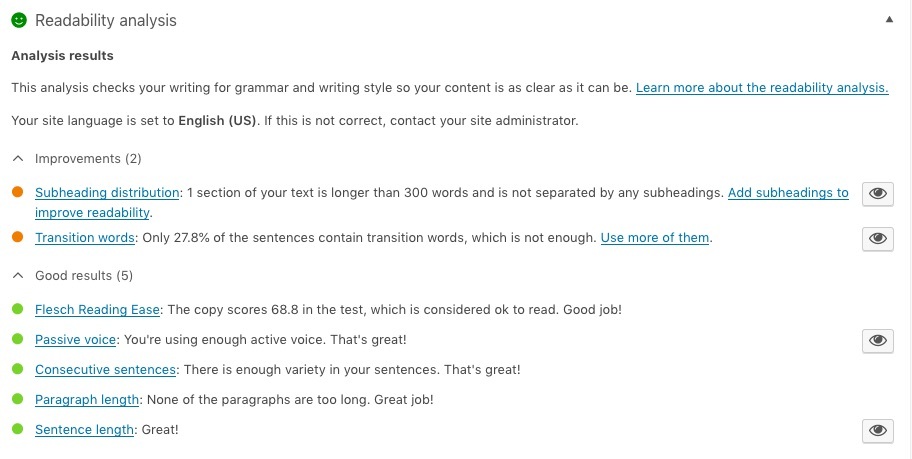
Clicking on the eye icon will highlight the sections where the analysis identified a problem:
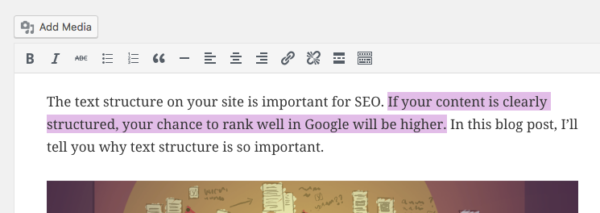
Now let’s solve this in step 4!
Step 4: Make readability adjustments
The readability analysis checks tell you where your article’s readability could be improved. If you tend to write long sentences, our analysis will show you which ones to rewrite. Split long sentences up into shorter sentences. If your paragraphs are too long, divide them up too. If you use a lot of passive voice, rephrase a few sentences. Here you can find all Yoast SEO’s readability assessments and instructions on how to get great scores.
Make sure that the overall bullet – the one on the upper right in the backend of your post – is green. The overall bullet will turn green if you have covered most of the readability aspects.
Step 5: Optimize your snippet
In Yoast SEO’s snippet preview you can see what your page might look like in the search results. If you click on edit snippet, you can adjust the SEO title, the URL and the meta description. By doing so, you can make your search result more enticing and convince people to click on your result.
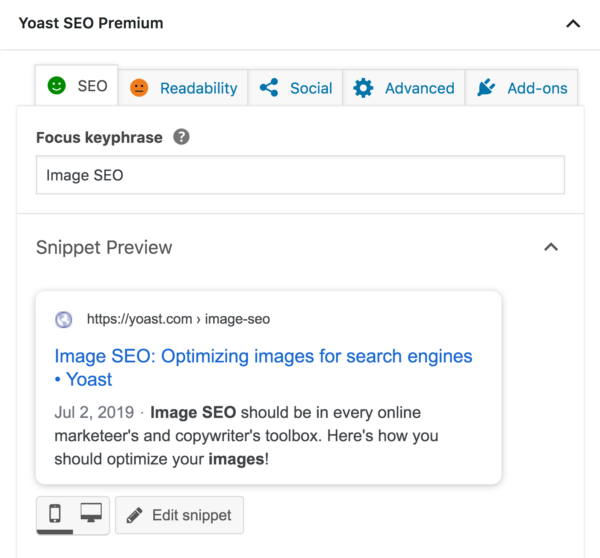
Keep reading: How to use the snippet preview of Yoast SEO »
Step 6: Check your SEO bullets
Go to the SEO analysis and check out those SEO bullets. Again, green tells you which aspects of your SEO are good, while orange and red indicates where you can improve your SEO strategy.
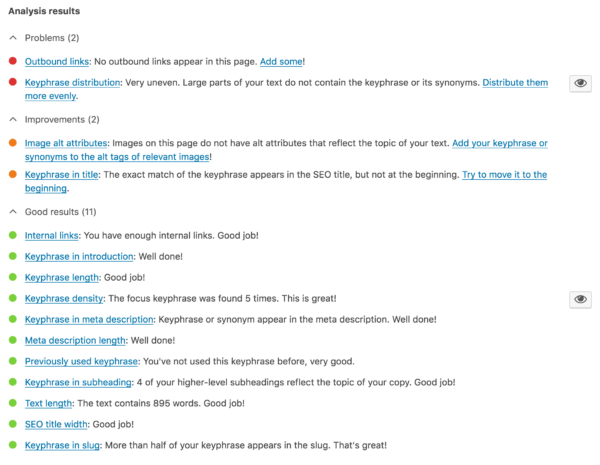
Do you see some red bullets on your post? Don’t panic, we’ll help you with that in step 5. But whatever you do, don’t change your focus keyword now! Why? Read The temptation of the green bullet to find out.
Step 7: Make SEO adjustments
The checks in the SEO analysis will show you where you can improve your SEO. Look critically at your title, the headings, and subheadings of your article. Do they include your focus keyphrase? If not, can you edit them (without changing the structure or content of your article) to include your focus keyword? Don’t go crazy and put your focus keyphrase in every heading, because that’s too much!
Your article should also include the focus keyphrase a couple of times, and if it’s not in your first paragraph, add it. As a general rule of thumb: try to use your search terms in about 1 to 2 percent of your text. Moreover, try to use synonyms and related keywords, as they’ll make your text easier to understand and can even enhance SEO.
Also, don’t forget to add links to related posts on your site and to check your images. Have you added an alt text? And are they the right size?
Remember, you don’t have to keep on optimizing until all of the bullets are green. Posts on Yoast.com often have a few orange bullets and sometimes even one or two red ones. The important thing is that the overall bullet should be green, which happens if most of your SEO aspects are covered.
Step 8: Fill out the social data
The final step is to add social data for your article. This means that you can instruct social media channels, like Facebook and Twitter, what to show when you share a page. You can add a social description, title, and an image with Yoast SEO. In Yoast SEO Premium you can even check what your page will look like when shared on social:
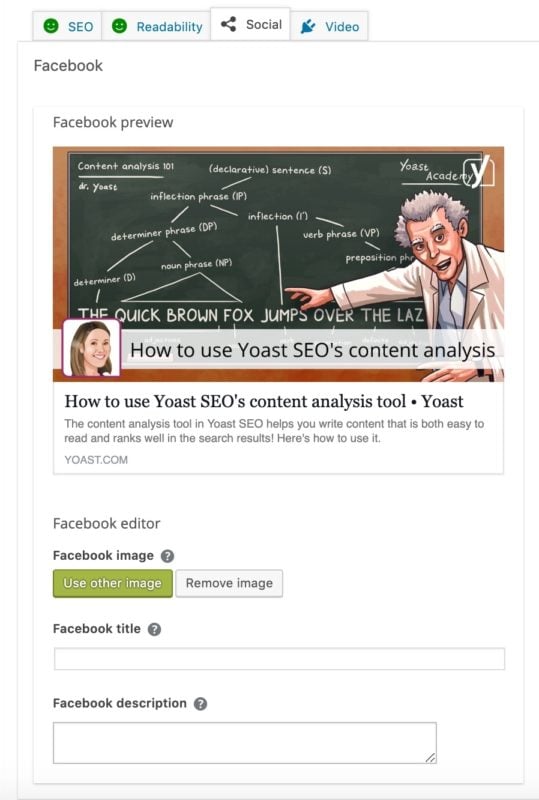
Time to publish!
Great, you’re ready to hit publish! Go ahead and go live. When it’s live, take a second to check what it looks like on your site. You might see things you haven’t noticed before. Also, don’t forget to monitor how your post or page is doing, because this will give you valuable input for improvement of the post at hand or future posts.
But what if you have all green bullets and still no rankings?
SEO copywriting with Yoast SEO
SEO copywriting is still hard work, but the content analysis tool in Yoast SEO makes the process of writing awesome, SEO-friendly articles much easier. For more practical tips, make sure you read SEO copywriting: the Ultimate Guide.

